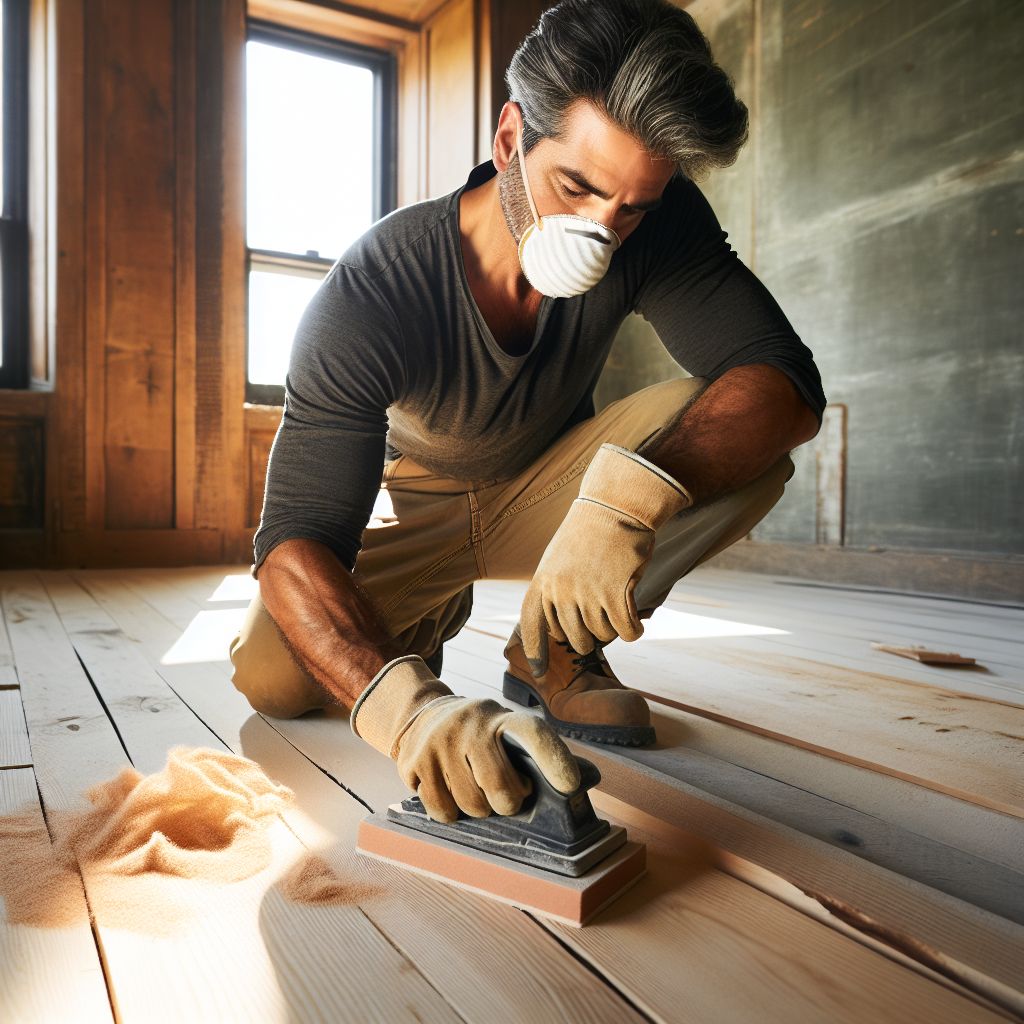
Key Takeaways
- Fir wood floors are softer and more challenging to refinish than hardwoods.
- Fir floors often have larger gaps due to the wood settling over time.
- Before starting, assess the thickness of your fir floors to ensure they can be refinished.
- Hand-sand the floors gently, due to the soft nature of fir wood, and vacuum up all dust.
- Apply stains or sealants carefully, keeping in mind fir wood’s tendency to vary in color.
Restoring the Beauty of Fir Wood Flooring
When you’re standing on an expanse of fir flooring that’s seen better days, the urge to bring it back to life is not just a renovation impulse—it’s a creative calling. Fir wood floors, with their distinctive grain and warm hues, are a treasure beneath your feet. But as any seasoned DIYer knows, they’re also softer and more challenging to refinish than hardwoods. Here’s how to refinish your fir wood floors and restore their natural beauty.
Prepping Your Fir Floors for Success
Before diving into the nitty-gritty of refinishing, let’s ensure you’re starting on the right foot. First things first, you need to check the condition of your fir floors.
Assessing the Condition of Your Fir Floors
Look for signs like deep gouges, stubborn stains, or warping. These can be red flags, indicating that a simple refinish might not cut it. But for the most part, typical wear and tear—scratches, dullness, and the occasional paint splatter—are your green lights for a DIY refinish.
Are they thick enough for another round of refinishing? If you can spot a lot of nail heads, it might be time to replace rather than refinish. But if it’s just a few, you’re likely dealing with a minor installation hiccup from the past, and you’re good to go.
Gathering Essential Tools and Materials
Now, let’s talk about what you’ll need. This isn’t a job for the unprepared. You’ll want to round up all the necessary tools and materials.
- A screwdriver for any protruding nails
- A broom or vacuum for keeping things clean
- Wood filler to patch up those character-building gaps
- A set of sandpaper, ranging from coarse to fine grit
- Tack cloths or cheese cloths for dusting off
- Your choice of stain or seal
- And of course, paint brushes and rags for application

Step-by-Step Fir Floor Refinishing
With your tools at the ready, it’s time to roll up your sleeves. The secret to a successful refinish is to take it step by step, respecting the wood’s characteristics and your home’s history.
Step 1: Floor Cleaning and Preparation
Start with a clean slate. Remove any furniture, rugs, and lingering dust bunnies. If you find any nails sticking out, now’s the time to sink them back into the wood with your trusty screwdriver. Afterward, give the floor a thorough sweep or vacuum. You’re setting the stage for a smooth refinishing process.
Once the floor is clean, inspect the gaps. Fir floors often have larger gaps due to the wood settling over time. Fill these gaps with wood filler, using a trowel to press it down firmly. This step is essential because it ensures a level surface, which makes sanding easier and the final result smoother.
Step 2: Sanding Techniques for Soft Fir Woods
Sanding is where the magic happens, but it’s also where things can go awry with fir floors. Because fir is a soft wood, you’ll want to sand by hand. It’s more labor-intensive, sure, but it gives you control. Start with a coarser grit to remove the old finish and work your way up to a finer grit for a smooth surface. Always sand in the direction of the grain to avoid scratches that are tough to remove.
After sanding, vacuum or sweep away the dust. Then, run a tack cloth or cheese cloth over the surface to pick up any remaining fine particles. This step is like prepping a canvas before painting; it ensures that your stain or seal adheres properly and looks even.
Step 3: Repairing Imperfections with Wood Filler
With your floor now smooth, take a moment to look for any remaining imperfections. Small cracks or holes can still be filled with wood filler after sanding. Just apply it, let it dry, and then give it a quick, gentle sand to blend it into the surrounding wood.
Remove all dust and debris from the floor using a vacuum and tack cloth. This ensures the surface is clean and ready for staining.
Step 4: Choosing and Applying the Right Stain
Choosing the right stain can be a bit like picking the perfect outfit—it sets the tone. Fir can vary in color from board to board, so decide whether you want to celebrate these natural variations or aim for a more uniform look. A colored stain will accentuate the differences, while a clear coat will unify them. Apply the stain with a brush or rag, working in sections and wiping away any excess to avoid splotches.
Step 5: Sealing for Longevity
The next step in the refinishing process is sealing your floors. This is the protective coat that shields your hard work from the wear and tear of daily life. A clear polyurethane coating is a good choice for fir floors. It protects without hiding the wood’s character. Apply it with a brush, following the manufacturer’s instructions, and allow it to dry completely before walking on the floor.
Step 6: Curing
Allow the sealant to cure according to the manufacturer’s instructions before placing furniture back in the room or allowing foot traffic on the floor. Proper curing ensures the sealant bonds completely with the wood and forms a durable protective layer. This prevents issues like uneven finishes, smudging, and premature damage, ensuring the surface stays smooth and resilient against everyday wear and tear.
Best Practices for DIY Fir Floor Projects
Refinishing fir floors is rewarding, but it’s also easy to stumble if you’re not careful. Here are some best practices to keep you on track:
Tips to Avoid Common Pitfalls
- Don’t rush the process—take your time with each step.
- Be gentle when sanding to avoid creating dips or uneven surfaces.
- Always test your stain on a small, inconspicuous area first.
- Ensure good ventilation when applying stains and seals.
- Wait for each coat to dry thoroughly before applying the next.
Working with Softwoods: Special Considerations
Remember, fir is a softwood, so it’s more prone to dents and scratches. This means you should be extra careful when moving furniture back into the room. Consider using felt pads under furniture legs to protect your newly refinished floors.

Post-Refinishing Care
Once the sealant is dry, you’ll want to keep those floors looking as good as new. Here’s how:
Maintaining Your Newly Refinished Floors
Regular sweeping and vacuuming are your first line of defense against scratches. For deeper cleaning, use a damp mop with a cleaner that’s safe for wood floors. And remember, water is wood’s enemy—so don’t let spills sit for too long!
Another tip is to keep the claws of your furry friends trimmed. Pets can unwittingly leave scratches, so it’s best to keep those nails short.
When to Call in the Professionals
If at any point you feel out of your depth, or if the project becomes too time-consuming, calling in a professional is a smart move. They can tackle stubborn problems or finish the job if you’re unable to.
Final Touches: Revealing the Beauty
After all your hard work, it’s time for the big reveal. Remove any dust sheets, open the windows, and let the light shine on your handiwork. Your fir floors should now radiate warmth and character, a testament to your effort and creativity.
The Final Review
Give your floors a final inspection. Look for any missed spots or imperfections. If you find any, a little touch-up might be necessary. It’s all about the details.
Enjoying Your Floors and Planning Future Care
Now, step back and enjoy the fruits of your labor. Your fir floors are not just refinished; they’re a canvas that reflects your creativity and care. And with proper maintenance, they’ll continue to add warmth and beauty to your home for many years to come.
Remember, this isn’t just about the floors—it’s about making your home truly yours. So, take pride in what you’ve accomplished and let it inspire your next creative home improvement project.

Frequently Asked Questions
How do I know if my fir floors are too thin to refinish?
To determine if your fir floors are too thin to refinish, check for exposed nail heads. If many are visible, it may indicate that the wood is too thin and refinishing could cause damage. In such cases, replacement rather than refinishing is the safer option.
Can I use a power sander on fir floors?
While you can use a power sander on fir floors, it’s recommended to sand by hand due to the soft nature of the wood. Power sanders can quickly cause uneven surfaces or dips, which are difficult to correct on such a soft material.
What type of stain should I use for fir floors?
For fir floors, use a stain that complements the natural variations in the wood. If you prefer a more consistent look, a clear polyurethane coat can help minimize color differences while still protecting the wood.
How often should I reseal my fir wood floors?
It’s generally recommended to reseal fir wood floors every 3-5 years, depending on the amount of foot traffic and wear they experience. Regular maintenance will keep them looking their best for longer.





Leave a Reply